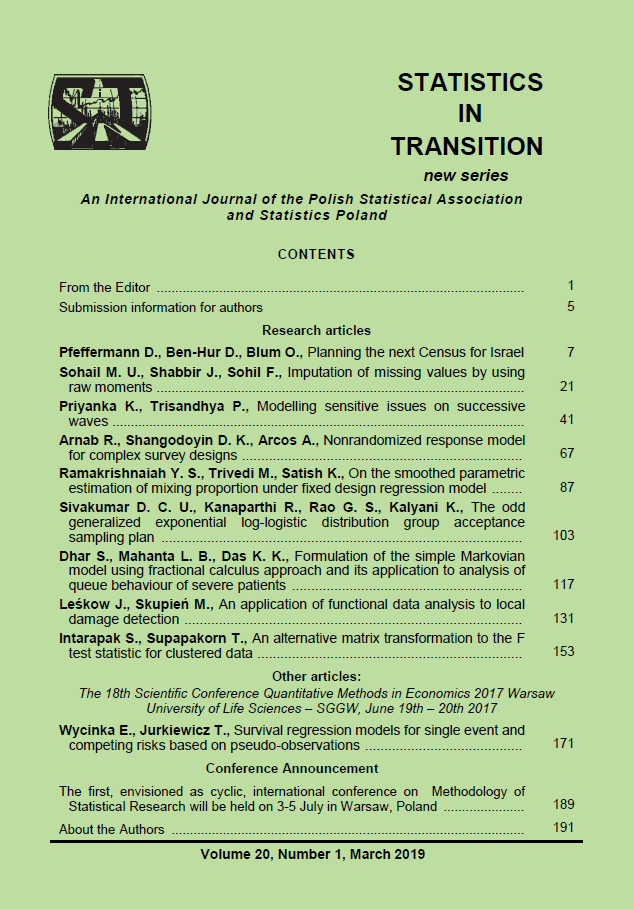ARTICLE
ABSTRACT
This paper addresses the problem of estimation of population mean of sensitive character using non-sensitive auxiliary variable at current wave in two wave successive sampling. A general class of estimator is proposed and studied under randomized and scrambled response model. Many existing estimators have been modified to work for sensitive population mean estimation. The modified estimators became the members of proposed general class of estimators. The detail properties of all the estimators have been discussed. Their behaviour under randomized and scrambled response techniques have been elaborated. Numerical illustrations including simulation have been accompanied to judge the performance of different estimators. Finally suitable recommendations are forwarded.
KEYWORDS
Sensitive variable, Successive waves, Scrambled Response model, Class of estimators, Population mean, Bias, Mean squared error, Optimum matching fraction.
REFERENCES
ARNAB, R, SINGH, S., (2013). Estimation of mean of sensitive characteristics for successive sampling, Comm. Statist.-Theo. Meth., 42, pp. 2499–2524.
ARCOS, A., RUEDA M., SARJINDER SINGH, (2015). A generalized approach to randomized response for quantitative variables, Qual Quant, Vol. 49, Issue 3, pp 1239–1256.
BAR-LEV, S. K., BOBOVITCH, E., BOUKAI, B., (2004). A note on randomized response models for quantitative data. Metrica, 60, pp. 255–260.
COCHRAN, W. G., (1977). Sampling Techniques. Third edition. New York:Johan Wiley.
DIANA, G., PERRI, P. F., (2010). New Scrambled response models for estimating the mean of a sensitive quantitative character, J. App. Statis., 37 (11), pp. 1875–1890.
DIANA, G., PERRI, P. F., (2011). A class of estimators for quantitative sensitive data, Stat. Pap., 52, pp. 633–650.
EICHHORN, B. H., HAYRE, L. S., (1983). Scrambled randomized response method for obtaining sensitive quantitative data. J. Statist. Plann. Infer., 7, pp. 307–316.
FENG, S., ZOU, G., (1997). Sample rotation method with auxiliary variable, Comm. Stat.- Theo. Meth., 26, pp. 1497–1509.
GREENBERG, B. G., KUBLER, R. R.,ABERNATHY, J. R., (1971). Horvitz, D.G., Application of RR technique in obtaining quantitative data, J. Amer. Statist. Asso., 66, pp. 243–250.
JESSEN, R. J., (1942). Statistical investigation of a sample survey for obtaining farm facts, Iowa Agri. Exp. Stat. Road Bull., 304, pp. 1–104.
MURTHY, M. N., (1967). Sampling Theory and Methods. Calcutta, India: Statistical Publication Society.
NAEEM, N., SHABBIR, J., (2016). Use of scrambled responses on two occasions successive sampling under non-response, Hacettepe University Bulletin of Natural Sciences and Engineering Series B: Mathematics and Statistics, 46. Available at http://www.hjms.hacettepe.edu.tr/uploads/32c18b80-275f- 4b5a-a28d-6a5890eecac3.pdf.
PATTERSON, H. D., (1950). Sampling on successive occasions with partial replacement of units, J. Royal Statis. Soci. 12, pp. 241–255.
POLLOCK, K. H., BEK, Y., (1976). A comparison of three randomized response models for quantitative data. J. Amm. Sta. Asso., 71, pp. 884–886.
PRIYANKA K., MITTAL, R., (2014). Effective rotation patterns for median estimation in successive sampling. Statis. Trans., 15, pp. 197–220.
PRIYANKA, K., MITTAL R., MIN-KIM, J., (2015). Multiariate rotation design for population mean in sampling on successive occasions. Comm. Statis. Appli. Meth., 22, pp. 445–462.
PRIYANKA K., MITTAL, R., (2015a). Estimation of population median in twooccasion Rotation Sampling. J. Stat. App. Prob. Lett. 2, pp. 205–219.
PRIYANKA, K., MITTAL, R., (2015b). A class of estimators for population median in two occasion rotation sampling. HJMS, 44, pp. 189–202.
PRIYANKA, K., MITTAL, R., (2016). Search of Good Rotation Patterns on Successive Occasions and its Applications. UGC sponsored Project report, No.: [42–42 (2013)/SR].
REDDY, V. N., (1978). A Study on the use of prior knowledge on certain population parameters in estim ation. Sankhya C., 40, pp. 29–37.
SEN, A. R., (1973). Theory and application of sampling on repeated occasions with several auxiliary variables. Biometrics, 29, pp. 381–385.
SRIVASTAVA, S. K., (1980). A class of estimators using auxiliary information in sample surveys, Cand. Jour.Stat., (8), pp. 253–254.
SINGH, H. P., RUIZ-ESPEJO, M. R., (2003). On linear regression and ratio-product estimation of finite population mean. The Statistician., 52 (1), pp. 59–67.
SENAPATI, S.C., SAHOO, L. N., (2006). An alternative class of estimators in double sampling. Bull. Malays. Math. Sci. Soc., (2), 29 (1), (2006), 89–94.
SAHA, A., (2007). A simple randomized response technique in complex surveys. Metron, LXV, pp. 59–66.
SINGH, G. N., PRIYANKA, K., (2008). Search of good rotation patterns to improve the precision of estimates at current occasion, Comm. Stat. Theo. Meth., 37, pp. 337–348.
SINGH, G. N., KARNA, J. P., (2009). Estimation of population mean on current occasion in two occasion successive sampling. Metron, LXVII (1), pp. 87–103.
SINGH, G. N., PRASAD, S., (2010). Some estimates of population mean in twooccasion rotation patterns. A.M.S.E., 47 (2), 1–18.
SINGH, G. N., SUMAN, S., KHETAN, M., PAUL, C., (2017). Some estimation procedures of sensitive character using scrambled response techniques in successive sampling, Comm.Statist-Theory and Methods, DOI: 10.1080/03610926.2017.1327073.
TRACY, D. S.,SINGH, H. P., SINGH, R., (1996). An alternative to the ratio-cumproduct estimator in sample surveys, Journal of Statistical Planning and Inference (53), pp. 375–397.
WARNER, S. L., (1965). Randomized response: a survey technique for eliminating evasive answer bias, J. Amer. Statist. Asso., 60, pp. 63–69.
YU, B., JIN, Z., TIAN, J., GAO, G., (2015). Estimation of sensitive proportion by randomized response data in successive sampling, Compu. Mathemat. Meth. Med, DOI: 10.1155/2015/172918.
